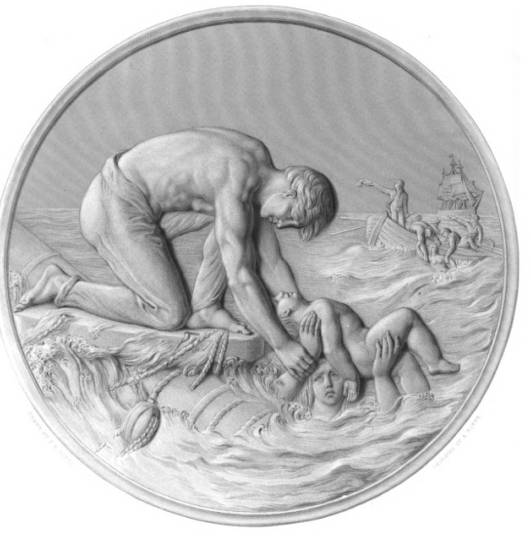
The Rescue by William Wyon “the principal engraver at the Royal Mint.” Image capture and formatting by George P. Landow. [You may use this image without prior permission for any scholarly or educational purpose as long as you (1) credit the Hathi Trust Digital Library and the University of Michigan and (2) link your document to this URL in a web document or cite the Victorian Web in a print one.]
Commentary from the Art-Journal
Among the numerous medals struck from the dies engraved by the late Mr. William Wyon, RA, the principal engraver at the Royal Mint, were several he executed for those benevolent societies established in our various maritime towns for the purpose of aiding shipwrecked or drowning individuals; these medals are presented as rewards where especial heroism has been exerted on behalf of such unfortunates, and it seems scarcely necessary to add they are prized as much as if their owners had won them on the field of battle, for in many instances they are the reward of courage unsurpassed” by that of the bravest warrior, and of dangers— voluntarily met and undauntedly overcome—more terrible than those which the soldier encounters in the hardest-fought engagement. There is no enemy more calculated to strike the stout heart with dismay, none so difficult to cope with, as the ocean "lashed into fury" by the tempest. In a country like ours, claiming to be the "mistress of the seas," whose navies and argosies are found in every part of the world, navigated” by thousands of her noblest sons, such institutions as these Shipwreck and Humane Societies ought to be far more liberally supported than we know them to be.
The medal from which the annexed print is taken was executed some few years since for tho society established at Liverpool: the design is most appropriate to the subject, and admits of the following reading. The wreck has evidently taken place at sea, and not on the coast, for there are no indications of land: a ship, which most probably has escaped the ravages of the storm, has seen some of the survivors struggling in the waters, and has sent a boat to their assistance; two of the boat's crew are signalling, as it would appear, some of the unfortunate who are not brought into the artist's composition, while others are lifting a drowning woman out of the sea. But the most touching group is that in the front of the design, consisting of a fine stalwart seaman (himself one of the wrecked party, as shown by his position on some broken portions of the vessel, to which probably he owes his life) saving a mother and her infant: there is a beautiful expression of maternal love, and of thought on the part of the seaman, in the acts of the two elder figures; the woman, anxious for the welfare of her child before her own, raises it up that it may be saved first; the seaman would rescue both, and therefore holds her firmly by one hand while he takes the infant with the other.
The art of engraving dies for medals, and of the sister art, that of cutting stones in intaglio, such as seals, &c, are both of very ancient origin: the Old Testament contains early and frequent allusion to them, as in the thirty-eighth chapter of Genesis, where Tamar obtains a pledge of Judah, by requiring his signet; and again in the thirty-ninth chapter of Exodus, where we are told that the stones worn in the sacerdotal breastplate were to be "like the engravings of a signet, every one with his name;" it is thus evident that engraving, or working in intaglio, must have been well known at the periods here referred to. The Greeks also carried this branch of the Fine Arts to the same perfection which their genius and feeling for the beautiful enabled them to reach in all others to which they de- voted their attention.
The art of engraving medals and coins is of far more practical importance than might generally be supposed. The study of such objects, when of an historical or national character, has proved of great assistance to the historian and antiquarian, and hardly less valuable to the man of taste. "To the former," it has been observed, "medals often afford information that cannot be obtained” by other means, in the inscriptions, legends, and allegories with which they are charged; while to the artist and connoisseur many of them offer not only exceedingly beautiful examples of Art, but, if their authenticity can be depended on, a series of medals is one of the best authorities that can be consulted for the state of the arts of design of any particular period.
Bibliography
“The Rescue.” Art Journal (1855): 84. Hathi Trust Digital Library version of a copy in the University of Michigan Library. Web. August 1, 2013.
Last modified 26 December 2011